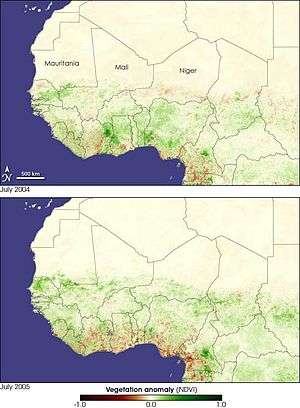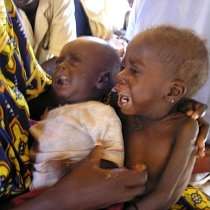2005–06 Niger food crisis

A severe but localized food security crisis occurred in the regions of northern Maradi, Tahoua, Tillabéri, and Zinder of Niger from 2005 to 2006. It was caused by an early end to the 2004 rains, desert locust damage to some pasture lands, high food prices, and chronic poverty. In the affected area, 2.4 million of 3.6 million people are considered highly vulnerable to food insecurity. An international assessment stated that, of these, over 800,000 face extreme food insecurity and another 800,000 in moderately insecure food situations are in need of aid.
Background
The crisis had long been predicted after swarms of locusts consumed nearly all crops in parts of Niger during the 2004 agricultural season. In other areas, insufficient rainfall resulted in exceptionally poor harvests and dry pastures affecting both farmers and livestock breeders. An assessment carried out by the government of Niger, the United Nations and international Non Governmental Organizations reached a general consensus that the crisis, while locally severe, had not reached the level of famine according to famine scales.
Crisis
According to current estimates, the Sahel region as a whole registered a grain surplus of 85,000 tons. However, Niger and Chad suffered grain deficits of around 224,000 and 217,000 tons, respectively. An increase in food prices is fuelling the food crisis, especially in Niger, where millions of people are facing risk of food shortages and outright starvation.

In the most affected areas of Niger, access to food staples is becoming increasingly difficult and severe cases of child malnutrition have been reported to be on the rise. The scarcity of water and fodder is adversely affecting the health of the cattles, camels, sheep and goats that comprise virtually the only source of food and income for nomadic communities. Competition for limited resources has also resulted in some local conflicts.

Acute malnutrition rates have risen to 13.4 per cent in the southern Niger Maradi and Zinder departments, with 2.5 per cent of this group identified as severely malnourished children under age five, says UNICEF quoting recent nutrition surveys by the United Nations and several non-governmental organizations.
The food shortage impacts some 3.3 million people —including 800,000 children under age five— in some 3,815 villages. Officials estimate cereal deficits at 223,448 tons and livestock feed deficits at 4,642,219 tons.
Although rains began early this year and have fallen regularly, initially inspiring hope for a better agricultural season, relief will not come before the harvest in October. Villagers are just now entering into the critical period known as the lean season — the months when food stocks are at their lowest. It is also the moment when farm workers need more caloric energy to cultivate their fields, since most of the agrarian labour in Niger is performed manually.

Response
In late August 2005, the profile of the crisis was raised after UN Secretary-General Kofi Annan visited President Tandja Mamadou in Zinder. The visit was seen as an attempt to draw attention to the crisis, and also address accusations that the UN had responded slowly. Donors have given less than half of the US$81 million appealed for by the UN.
On January 16, 2006, the UN directed an appeal for US$ 240 million of food aid for West Africa to feed at least 10 million people affected by the food crisis, with Niger being the worst-affected country.[1]
Controversy on media coverage
From the onward of media coverage, several local authorities, including the President of Niger at the time, called into the question the veracity of claims made by international media. The main argument was that, while chronic malnutrition has been issue for populations of Niger, media erroneously and deliberately portrayed common local dietary habits as sign of widespread famine to appeal to donors' sympathy. On March 3, 2008 TV2 Norway aired the documentary "Sultbløffen" (The Famine Scam) which voice the view that there was no famine in Niger in 2005-06 but rather chronic malnutrition no different from the previous years. BBC's Hilary Andersson, UN Emergency Relief Coordinator Jan Egeland as well as international media and aid organizations in general were accused of severely overstating and lying about the food situation in the country by misrepresenting the situation. The sources, among them a Norwegian-Swedish foundation of agricultural development and their local assistants, gave a version picturing western media and relief agencies as ignorant towards local agriculture and flora and common dietary habits. They cited so-called "food-racism": the perception that local, traditional food and food plants are useless and poisonous, despite the fact that the locals have eaten these for millennia. They also denounced the portrait presented which reinforce the perception that the people of Niger are incapable of living without support from the west, and argue that large food donation flowed the local supply making it harder for local agriculture to compete.[2] The film was awarded 3rd prize in the Monte Carlo TV festival of 2008, and won Den Store Journalistprisen in Norway in 2009. BBC attempted to block the international release of the documentary by withdrawing TV2's license to news footage from the summer of 2005.[3]
See also
References
- ↑ http://www.alertnet.org/thenews/newsdesk/L16774239.htm
- ↑ Sultbløffen (The Famine Scam) awarded third place Monte Carlo TV festival of 2008
- ↑ BBC's attempt to block international release of documentary critical of its coverage of the Famine of 2005-06 in Niger
External links
- Jeevan Vasagar, The Guardian, August 1, 2005, "Plenty of food - yet the poor are starving: The two faces of Niger"
- NIGER: AN EVIDENCE BASE FOR UNDERSTANDING THE CURRENT CRISIS, (PDF) Famine Early Warning Systems Network, 29 July 2005
- Updated news links from ReliefWeb
- USAID Assistance to Niger/Sahel - Information on relief efforts and ongoing bilateral assistance from the United States Agency for International Development
- Egeland accused of bluffing about starvation
- http://www.unicef.org/media/media_27620.html
- UN chief tours impoverished Niger, BBC News, 23 August 2005
- The Economist: Starving for the cameras, Destitution not dearth, The worst is over
- SOS Children Appeal
- Media pressured over food crisis - IFEX
- Anuradha Mittal and Frederic Mousseau, "Sahel: A Prisoner of Starvation? A Case Study of the 2005 Food Crisis in Niger" [PDF file], The Oakland Institute, October 31, 2006.
- TV2, The Famine Scam